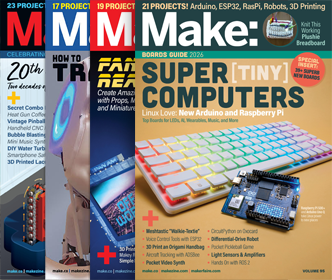
The steampunk craze has calmed quite a bit since the aughts when there was general and widespread enthusiasm for the genre. Things like Jake von Slatt’s and Datamancer’s (RIP) beautiful and brassy tech mods, Abney Park’s airship pirate music, and happenings like the Contraptor’s Lounge, the steampunk salon we hosted at the 2008 Maker Faire Bay Area, delighted and inspired many. It was undeniably exciting to put Jake von Slatt on the cover of Make: Volume 17 with his Wimshurst Influence Machine (aka static electricity generator) — that you could make yourself! At home! With parts from Home Depot!
Steampunk began as an alternative history sci-fi sub-genre in the 1990s. At its core, it posited alternative Victorian histories in which steam-powered computation had created a digital revolution 100 years ahead of time. But the steampunk “meme” didn’t really take off as a full-fudged art, cosplay, and tech-modding culture until the early 21st century. Once really impressive case mods by Jake von Slatt, Datamancer, and others began going viral, interest in all things steampunk became extremely high, with popular sites like Boing Boing, Wired, Gizmodo, and Make: embracing the genre. People seemed to be having a good time outdoing each other (and themselves) with more elaborate and characterful steampunk creations. Sales of steampunk art and coffee table books, original fiction and fiction anthologies spiked. Steampunk aesthetics quickly found their way into film, music videos, art, even onto the runway fashions of the likes of Jean Paul Gaultier and John Galliano. It seemed as thought, overnight, steampunk was everywhere.
But, as quickly as it emerged and spread into many corners of our culture, it seems to have just as quickly lost much of its er… steam. Steampunk cosplay, art-making, tabletop and roleplaying gaming, tech modding, and of course, steampunk fiction, all still enjoy committed, albeit much smaller, followings. And steampunk has now become one of many style and aesthetic choices for a whole host of design disciplines. But one would suspect that history will crown the aughts as the golden age of steampunk.
Regardless of what you think of steampunk as an idea, as an aesthetic, one thing that I hope people can agree on is that it represents a fantastic example of taking an imagined world and applying your skills as a maker to giving birth to that world. When Jake von Slatt gave his keynote at the 2008 California Steampunk Convention, he began with: “I am first and foremost a maker” and went on to say that steampunk was simply the subject, the currently preferred theme of his making, but it was the making part that was most important to him.
I personally hope that the big takeaway from steampunk is that it showed people just how much fun you can have bringing elements of a beloved fantasy world, an imagined world, to life. Just as with von Slatt, for many, steampunk became a carrier wave upon which so much amazing making, community building, and art creation happened. Steampunk was also a reaction to the “gray box syndrome” of the boring, depersonalized tech of the turn of the century. Just like Make:’s original core mission of “Technology on your time,” steampunk was a way of taking control of the tech in your life, modifying it, making it your own, and even making it whimsical, a means for creative self-expression. I think that spirit is still very much alive in all sorts of high-tech making and modding that has come since.

What you may not be aware of is the fact there is also an excellent, award-winning, and equally inspiring documentary that was created as a companion to the book. The Vintage Tomorrows film contains many of the same cast of characters that are interviewed and featured in the book, folks like Bruce Sterling, William Gibson, Cory Doctorow, Cherie Priest, Jake von Slatt, Libby Bulloff, Ann and Jeff VanderMeer, the Neverwas Haul crew, and many more. The film is beautifully shot, and like the book, really does an admirable job of presenting the steampunk genre in such a way that, even if it’s not an aesthetic you particularly like, you can understand its allure to those for whom it resonates. As Make:’s Dale Dougherty is fond of reminding us, at their heart, makers are enthusiasts. And this film does a fine job of capturing the enthusiasm that one group of makers found in this thought-provoking, retro-futuristic genre.
The Vintage Tomorrows documentary is available for viewing on iTunes starting today. You can also buy the DVD on Amazon.
ADVERTISEMENT










